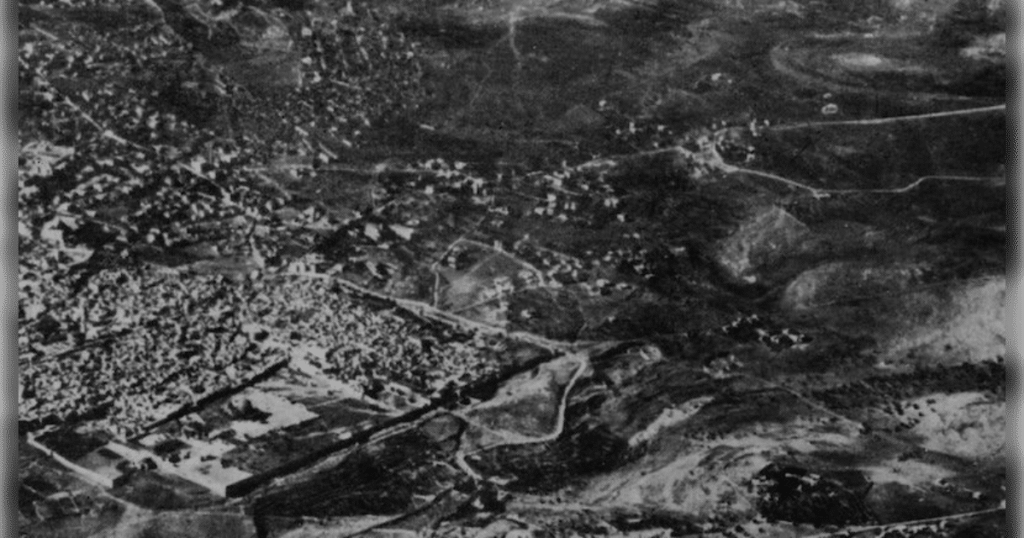The earliest aerial photograph of Jerusalem (lower left) with an oval fortification visible on a hill in the upper right. Public Domain, from the collection of the Library of Congress.
Researchers have uncovered an ancient military base that could potentially substantiate a Bible story involving God’s angels defending Jerusalem from an Assyrian invasion, the Daily Mail reported.
The story, as told in the Bible, recounts how God sent an angel to thwart an army of Assyrian soldiers intent on conquering the Holy Land around 2,700 years ago. The Angel of the Lord is said to have descended upon the advancing military, killing 185,000 soldiers in a single night.
Up until now, there has been no archaeological evidence to substantiate this event or even the battle itself. However, archaeologist Stephen Compton, utilizing modern mapping techniques, claims to have found compelling evidence that this epic confrontation indeed occurred.
According to the press release:
A peer-reviewed paper in the prestigious journal Near Eastern Archaeology reports the first-ever discoveries of ancient Assyrian military camps. Created circa 700 BC during military conquests across the Middle East, they mark the expansion of the Assyrian Empire, which became the prototype for the subsequent Persian, Greek, and Roman empires.
The initial discovery came from a scene carved into the stone walls of the Assyrian King Sennacherib’s palace commemorating his conquest of Lachish, a city to the south of Jerusalem. Matching the landscape in this image to features of the actual landscape (using early aerial photographs of Lachish prior to modern development) created a virtual map to the site of Sennacherib’s camp. This led to ruins similar in size and shape to the camp in Sennacherib’s relief.
An archaeological survey of the site found no evidence of human habitation for 2600 years, followed by pottery sherds from the exact time of Sennacherib’s invasion of Lachish, after which it was again abandoned for centuries. Moreover, the ancient Arabic name for the ruins was Khirbet al Mudawwara, “The Ruins of the Camp of the Invading Ruler.”
The Assyrians, an ancient civilization from Mesopotamia, formed a formidable empire in the Near East, according to Britannica. The Assyrians were frequently depicted as fierce and ruthless conquerors who lived in the area of present-day northern Iraq and southeastern Turkey. Sennacherib was the king of the Neo-Assyrian Empire from 705 BC until his death in 681 BC.
Three Bible stories, Isaiah 37:36-38, 2 Kings 19:35, and 2 Chronicles 32:21, detail how the Assyrian soldiers were slain on the eve of their attack on Jerusalem.
Isaiah 37:36-38 (New International Version)
Then the angel of the Lord went out and put to death a hundred and eighty-five thousand in the Assyrian camp. When the people got up the next morning—there were all the dead bodies! So Sennacherib king of Assyria broke camp and withdrew. He returned to Nineveh and stayed there.
One day, while he was worshiping in the temple of his god Nisrok, his sons Adrammelek and Sharezer killed him with the sword, and they escaped to the land of Ararat. And Esarhaddon his son succeeded him as king.
Below are the pictures from the peer-reviewed paper, The Trail of Sennacherib’s Siege Camps, by Stephen C. Compton.
The earliest aerial photograph of Jerusalem (lower left) with an oval fortification visible on a hill in the upper right. Public Domain, from the collection of the Library of Congress.
Bottom: The entire scene from Sennacherib’s palace wall as drawn by its excavator, Austen Henry Layard, in 1849. Top: The same landscape as photographed from a plane in 1945, prior to modern alterations to the landscape. Correlating the two indicated a likely location for the ruins of Sennacherib’s camp. Created from two public domain images: Austen Henry Layard’s 1849 excavation drawings of the Lachish relief and a 1945 aerial photograph taken as part of a mapping effort by the British Mandate government of Palestine.
Ruined walls visible today at the site of Sennacherib’s Lachish camp. S.C. Compton
Stone panels commemorating the conquest of Lachish from the walls of the Assyrian Emperor Sennacherib’s palace show his military camp. The twenty-four guard towers in the camp’s perimeter wall, each with three windows visible, indicate a substantial fortification. S. C. Compton
The site of Sennacherib’s Jerusalem camp, now known as Ammunition Hill. S.C. Compton
The post Ancient Military Base Discovered, Potentially Corroborate Bible Story of God’s Angel Killing 185,000 Assyrian Soldiers appeared first on The Gateway Pundit.

